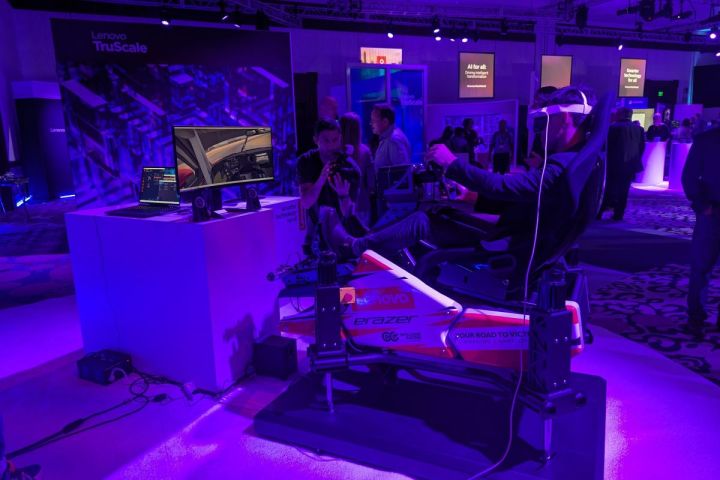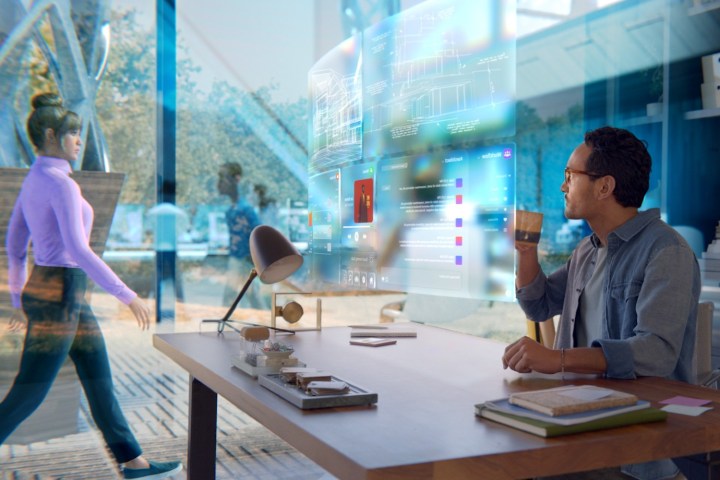There was a lot of hope in the mid-2010s that virtual reality would take off and become the next big thing in home entertainment. Many brands invested in VR headsets that would be connected to PCs and gaming consoles to take users seamlessly from a 2D environment to an immersive 3D world. While enthusiasts might have jumped on the bandwagon quickly, many consumers have yet to invest in the ever-prevalent technology, much to the chagrin of Meta (formerly Facebook) CEO Mark Zuckerberg and his burgeoning metaverse.
The concept of VR hasn’t gone away and has gradually morphed into extended reality (XR) via further upgrades as we progress into the mid-2020s. Hardware has become smaller, lighter, and wireless. Companies including Meta and Apple market their XR headsets, the Meta Quest 3 and the Apple Vision Pro respectively, as entertainment devices with several enterprise capabilities built in. But other companies are taking a different approach.
Lenovo’s vision of XR

After years of the industry attempting to make VR/XR an enjoyment-first medium, Lenovo has considered the enterprise space as the most direct avenue to give users their first experience with headsets. I spoke with Jason McGuigan, Lenovo’s head of commercial VR, during the brand’s Tech World 2023 conference about how its collaboration with businesses is allowing would-be consumers to try XR before they buy.
Despite various headsets being available for approximately a decade, McGuigan estimated that between 50% to 60% of the market has not tried XR in any capacity. Companies such as Chick-fil-A, Walmart, or a call center might use VR to train their new employees, and that might be their first time in contact with a headset.
He noted that having those first XR experiences at work demystifies a lot of the questions that people might have about how the technology operates without any initial investment on their part. Many are expecting more of a flat panel in front of the face when putting on a headset, or a 3D television experience.
“The immersion surprises everybody. The connection that they have to the content surprises everyone. Then they become a fan of it. We have had many people that have told us that they started off by using their headset at work, and then they got one for personal use at home. We’re going to see a lot of that translation for the consumer market, but we’re going to see that growth as we’re seeing more and more content being developed. It becomes ultra-specific to everybody,” McGuigan said.
The faltering of immediate consumer interest has been a win for the enterprise space. Many organizations have been investing in XR as a time-saving and cost-saving mechanism. They can use headsets for several purposes, from employee training to remote collaboration in VR. Some organizations are developing even more use cases as newer generative AI technology becomes available.
AI and XR unite

Over the last decade, businesses have been able to rationalize the cost metrics of investing in XR a lot more than any individual consumer can. If a consumer-marketed XR headset is available, it is open to much more scrutiny over its size, design, comfort level, and whether or not the device is worth its price tag, even for enthusiasts. Meanwhile, employees don’t have much choice on if or how a headset is being used in the enterprise space. Aspects such as maximum comfort might be overlooked in favor of cost savings for a company because devices are likely not being used for an extended period in a work setting. These are things companies can easily calculate the benefits of in terms of time, money, and cost, McGuigan noted.
“With early technologies, the investment is heavy. The enterprise has more to invest because they have more to gain. If I’m an individual gamer and I buy a VR headset, I get the satisfaction out of my one use. Whatever I’m using it for, how often I use it, I have to build that metric. This is so much that I spent on it and this is what I’m getting out of it. Does that meet my entertainment quota for what I spent on it? I spent $500, when do I get my $500 back in return on investment for my personal satisfaction?” he said.
Similar to the hardware, XR requires compatible software and services that are currently much more lucrative in the enterprise space than for consumers. With the modern advent of generative AI, many companies, including Lenovo, are using the technology to create propelled solutions for many different industries.
It allows different companies to quickly develop proprietary solutions that require only a login for access. Projects that required six months to execute have been truncated to six weeks, allowing for time to consider additional use cases. This brings up challenges, such as what happens when the technology is updating while a company is rolling out a project. However, the collaboration of XR and generative AI in the enterprise space has the potential to point to growth for the industry, driving Lenovo’s business as a whole.
“Anybody in the enterprise that is building their own content that has a high level of cost, and that same reduction in cost is going to [apply to] traditional game developers, traditional XR developers, and consumer developers,” McGuigan said. “Someone that was creating a traditional video game last year without any of these tools, maybe they needed to hire external resources for voice talent. Maybe they had programming needs. Maybe they were a decent programmer, but a great artist; maybe they’re a great artist, but a terrible programmer. All those things can get unlocked by using generative AI, and now, they can create games, XR applications, all things that can then get translated out to the end user.”
A not-so-distant future

As generative AI becomes more ubiquitous in the enterprise space, benefits toward the consumer XR space are likely to become more apparent. A populous of content created by generative AI will likely usher in the compact XR devices that will be most appealing to consumers for at-home and entertainment purposes.
McGuigan notes the XR headsets have had a similar trajectory to the television and the portable phone, which started as large bulky devices with few functionalities. However, as they gained additional content and faster modes of producing said content, the smaller and more efficient they became.
“We’re not millennia away from it. We’re maybe 10 years before something becomes super light and easy, but when it becomes that easy, it’s going to be the best way to experience it. Because if we’re all sitting in our homes having this conversation, we put on a pair of glasses and it seems like you’re sitting right there. We’re going to do that rather than just picking up the phone because it’s going to be a lot more of an interactive, fun, and enjoyable experience,” McGuigan said.
Editors’ Recommendations
Services Marketplace – Listings, Bookings & Reviews